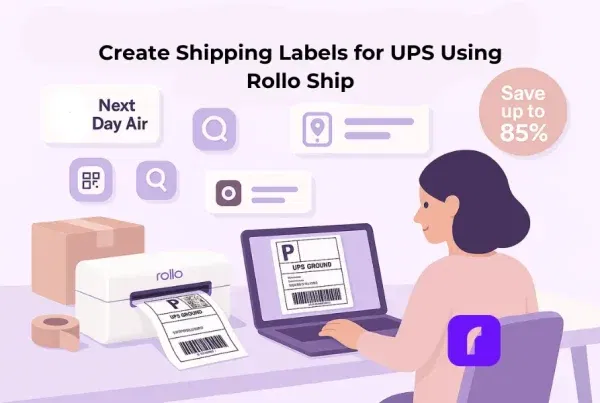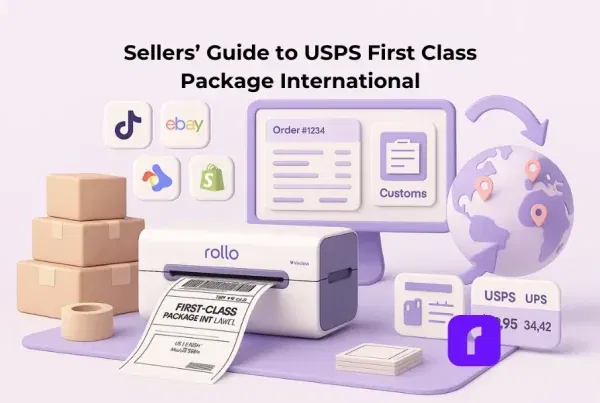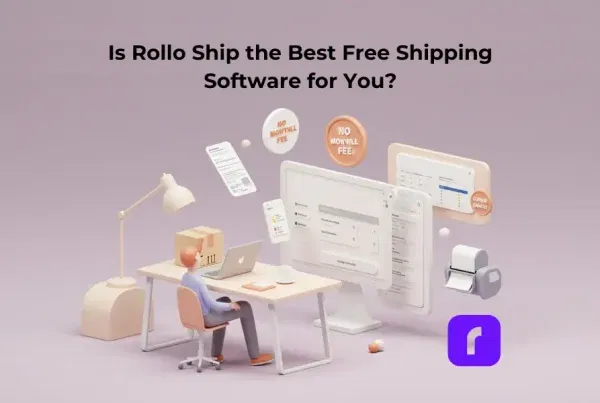In the bustling world of business, particularly for small enterprises, the significance of efficient and effective branding cannot be overstated. Among the myriad tools at a business’s disposal, barcode printers stand out as a crucial component for inventory management and brand labeling. Rollo, as a frontrunner in this arena, offers innovative solutions tailored to meet these needs. This article delves into how Rollo’s barcode printer revolutionizes the process of brand labeling, offering insights and practical advice to leverage these tools for your business’s success.
Table of Contents
Selecting the Ideal Barcode Printer for Your Business Needs

For small businesses, the choice of a barcode printer can significantly impact operational efficiency. Rollo’s range of barcode printers, designed with small businesses in mind, caters to various requirements. Whether you’re an online retailer, a brick-and-mortar store, or a hybrid, Rollo printers offer compatibility and versatility.
The Rollo Wireless Label Printer stands out for its convenience and ease of use. It’s perfect for businesses operating in dynamic environments where mobility and flexibility are key. On the other hand, the Rollo USB Label Printer, with its robust connectivity options, is ideal for stationary setups, offering reliability and high-volume barcode label printing capabilities.
Rollo’s Advanced Label Printers: A Game-Changer in Label Printing
Rollo label printers are not just about printing labels; they are about transforming the way businesses handle branding and logistics. The Wireless and USB Label Printers both use direct thermal printing technology, eliminating the need for ink or toner, which is a cost-effective solution for small businesses. With up to 650,000 shipping label capacity and a 203 dpi resolution, these printers ensure the clarity and longevity of your labels.
One of Rollo’s unique features is its intelligent label detection. This technology simplifies the barcode printing process by automatically identifying and aligning different label sizes, a boon for businesses that use a variety of label types.
Start Barcode Label Printing.
Efficiently, Fast, Eco-friendly.
The Efficiency of Thermal Barcode Printing
Thermal barcode label printing, a technology Rollo’s barcode printer utilizes, is a boon for businesses looking for efficiency and quality. This method uses heat to produce images on labels, eliminating the need for ink, toner, or ribbons. This not only reduces ongoing costs but also ensures fewer mechanical issues, leading to less downtime and maintenance.
The direct thermal barcode printing technology is particularly suited for businesses that require quick, on-demand printing, such as e-commerce platforms, where time and accuracy are of the essence.
How to Print Barcodes from Excel Using a Rollo Barcode Printer

1. Preparing Your Data in Excel
- Firstly, it’s important to have your product information neatly organized in an Excel spreadsheet.
- Each product should have a unique identifier, like a product code or SKU (Stock Keeping Unit). For instance, if you’re managing a clothing store, your Excel sheet might have columns for Item ID, Description (like ‘Blue T-shirt’), Size, and Price.
2. Generating Barcodes in Excel
To convert these identifiers into barcodes, you have two main options:
- Excel’s Barcode Font: Excel supports barcode fonts that can transform your text data into barcode format. You simply install the barcode font and apply it to the data column in your Excel sheet.
- Online Barcode Generators: These tools allow you to input your data and generate a barcode image file. You can then import these images back into your Excel spreadsheet. For instance, you could use an online generator to create barcodes for each product code in your inventory.
3. Setting Up Your Rollo Barcode Printer
Connect your Rollo barcode printer to your computer:
- For Setting Up the Rollo Wireless Barcode Label Printer – Refer to this guide.
- For Setting Up the Rollo USB Barcode Label Printer – Follow these instructions.
Ensure you have the correct label size loaded in the printer.
Rollo barcode printers support a range of sizes, making them versatile for various barcode printing needs.
4. Printing Your Barcodes from Excel
With your Rollo barcode label printer set up and your barcodes ready in Excel, it’s time to print:
- Highlight the cells containing your barcode data.
- Go to ‘File’ > ‘Print’ in Excel.
- Select your Rollo barcode printer from the list of printers.
- Adjust the print settings to match the size and layout of your labels.
- Click ‘Print’ to start printing your barcode labels.
Mastering Barcode Label Printing with Rollo
Rollo barcode printers are designed for simplicity and adaptability in printing barcode labels. Whether you’re labeling products for sale, shipping goods, or managing inventory, the process is streamlined:
- Load Labels: Insert the label roll or fanfold labels into your Rollo barcode label printer.
- Design Barcodes: Use any standard design software or opt for Rollo’s tools to create your barcode labels. You might design a label for a new line of products with both the product’s barcode and its name clearly printed.
- Print: Once your design is ready, send it to the Rollo barcode printer. The printer accommodates various label sizes, perfect for different applications, from small price tags to larger shipping labels.
Designing Custom Barcode Labels with Rollo’s Free Label Designer

Rollo’s Label Designer tool elevates barcode labels from mere functional items to integral parts of your branding strategy. With this tool, you can:
- Import Your Logo: Customize your barcode labels with your brand’s logo for enhanced brand recognition.
- Include QR Codes: Add QR codes linking to promotional content, your website, or digital thank-you notes. For example, a QR code on a product label could lead customers to a video demonstrating the product’s use.
- Generate Barcodes: Directly create barcodes within the tool, integrating them seamlessly into your custom label design.
- Incorporate Brand Elements: Use the tool to add colors, fonts, and images that align with your brand identity. This could mean using specific color schemes that reflect your brand or adding unique graphics that resonate with your brand story.
This structured approach to using Rollo’s barcode printer and design tools can significantly enhance the efficiency and effectiveness of your product labeling and branding efforts. By integrating these steps into your workflow, you can ensure that your products are not only easily identifiable and trackable but also carry a strong brand presence in the market.
Generate, Import, and Design Labels with QR Codes and Barcodes.
Create and Print Directly to Your Barcode Printer.
Useful Tips for Barcode Generation
Generating barcodes that are both efficient and reliable is key to smooth business operations, especially when it comes to inventory management and sales tracking. Here’s how you can ensure your barcodes meet these crucial standards:
1. Ensure Clarity: High Contrast Is Key
- Color Contrast: Make sure there’s a stark contrast between the barcode itself (usually black) and the background (typically white). This contrast is vital for scanners to easily read the barcode. Avoid using colors like red or green for the barcode or background, as these can cause issues with optical scanners.
- Clear Printing: Ensure that your Rollo barcode printer is producing crisp, clear prints. Blurry or smudged barcodes can lead to scanning errors. Regularly clean your barcode label printer to maintain print quality.
2. Maintain Standard Sizes: Adherence to Universal Readability
- Standard Dimensions: Use industry-standard dimensions for your barcodes. For instance, a typical retail barcode (EAN-13 or UPC-A) should be about 1.469 inches wide and 1.02 inches high, including the quiet zones (blank margins) on either side of the bars.
- Scaling Barcodes: If you need to scale your barcode, do it proportionally. Disproportionate scaling can distort the barcode, making it unreadable. Rollo’s design tools can help maintain these proportions automatically.
- Quiet Zones: Ensure there’s adequate space around the barcode. The quiet zone is typically 10 times the width of the narrowest bar in the barcode. This space is crucial for scanners to distinguish the barcode from other texts or designs on the label.
3. Test Scannability: Regular Testing With Various Scanners
- Use Different Scanners: Test your barcodes with various types of scanners to ensure universal readability. This includes handheld scanners, mobile scanning apps, and industrial scanners.
- Real-World Testing: Test barcodes in the environment they’ll be used. Factors like lighting, distance, and angle can affect scanning. For example, a barcode that scans well in a brightly lit office might not scan as easily in a dim warehouse.
- Regular Audits: Conduct regular scanning tests as part of your quality control process. This ensures any issues with barcode clarity or printing can be identified and rectified promptly.
By following these tips, you can enhance the efficiency and reliability of your barcode system. This leads to smoother transactions and inventory processes, ultimately contributing to a more streamlined and successful business operation. Remember, the effectiveness of your barcode system greatly depends on the initial design and ongoing maintenance of your barcodes. Using a Rollo barcode printer ensures high-quality prints, but it’s equally important to design and test your barcodes with these best practices in mind.
Choosing the Right Labels for Your Barcode Printing Needs

Selecting the right labels is vital for the longevity and effectiveness of your barcodes. Rollo offers a variety of eco-friendly, FSC-certified, and BPA-free thermal labels. These labels are not only environmentally responsible but also ensure high-quality prints. When choosing labels, consider factors like adhesive quality, durability, and resistance to elements like water and heat.
Use Thermal Barcode Labels
Ensure Barcode Perfection
The Business Benefits of Using a Thermal Label Printer for Inventory
For small businesses, the choice of technology used for inventory management can significantly impact overall efficiency and cost-effectiveness. Rollo’s thermal label printers offer a range of benefits that make them an ideal choice for such businesses. Let’s delve deeper into these advantages:
1. Cost-Effective: Minimizing Operational Expenses
- No Ink or Toner Needed: Unlike traditional inkjet or laser printers, thermal printers don’t require ink cartridges or toner, leading to substantial savings over time. For a small business, where every dollar counts, this reduction in consumable costs can make a significant difference.
- Reduced Maintenance Costs: Thermal printers have fewer moving parts compared to other types of printers, which means there’s less that can go wrong. This lower maintenance requirement translates into reduced costs for repairs and servicing.
- Longevity of Equipment: Generally, thermal printers have a longer lifespan due to their simplicity and durability. This means a longer interval before replacement is needed, offering a better return on investment.
2. Time-Saving: Enhancing Productivity
- Rapid Printing Speeds: Rollo’s thermal label printers are capable of printing labels rapidly – often one label per second. This speed enables businesses to complete labeling tasks more quickly, freeing up time for other essential activities.
- Ease of Use: The simplicity in the design of thermal printers means less time spent on training staff. The straightforward process of loading labels and printing them directly from applications like Excel or Rollo’s own software minimizes the learning curve.
- Immediate Label Output: Thermal printing creates labels that are dry and ready to use immediately, eliminating any wait time for ink drying, which can be a bottleneck in operations that require quick turnaround.
3. Space-Saving: Optimizing Workspace
- Compact Design: Rollo printers are known for their compact footprint, making them suitable for small offices or retail spaces where every inch of space is valuable. This compactness allows for more efficient use of the workspace.
- Flexibility in Placement: Due to their size, thermal printers can be conveniently placed in multiple locations, such as a shipping station, a warehouse corner, or beside a checkout counter, optimizing workflow.
4. Eco-Friendly: Promoting Sustainable Practices
- Less Waste: Thermal printers produce less waste compared to inkjet or laser printers. Since there are no cartridges or toners, there’s a significant reduction in plastic waste.
- Energy Efficient: Thermal printers generally consume less power than traditional printers, which not only reduces electricity costs but also minimizes the carbon footprint of the business.
- Eco-friendly Label Options: Many thermal labels, including those offered by Rollo, are made with eco-friendly materials, further supporting sustainable business practices.
Additional Specific Benefits for Small Businesses
- Accurate Inventory Tracking: With clear, durable labels, inventory tracking becomes more precise, reducing errors in stock management.
- Customizable Labeling Solutions: The ability to create customized labels on-demand, including barcodes, QR codes, and detailed product information, enhances brand visibility and customer engagement.
- Improved Compliance: For businesses in sectors that require strict labeling standards (like food, pharmaceuticals, or logistics), thermal printers offer the precision and consistency needed for compliance.
Rollo’s thermal barcode printers not only provide direct financial benefits through cost savings but also contribute to greater operational efficiency, space optimization, and environmental sustainability. These advantages are particularly crucial for small businesses looking to grow and maintain competitive in an increasingly challenging market.
Looking Ahead: The Future of Barcode Printing in Branding and Inventory Management
The barcode printing industry is continually evolving, with advancements in technology and changing market needs. This section will explore upcoming trends and potential innovations in barcode printing, particularly as they pertain to branding and inventory management.
Final Words
In conclusion, Rollo’s barcode printers offer a blend of efficiency, versatility, and innovation, making them an invaluable asset for small businesses. Whether it’s through their cutting-edge label printers, eco-friendly label options, or user-friendly design tools, Rollo is committed to empowering businesses in their branding and inventory management endeavors.
Follow Rollo on:


